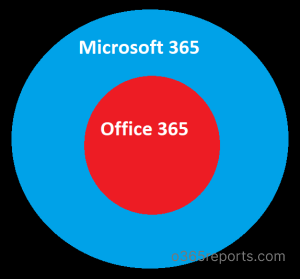As far as we know, people tend to mix up Office 365 with Microsoft 365. They believe Microsoft 365 and Office 365 refer to the same set of services offered by Microsoft. However, this is not the case. Office 365 is a small portion of the service that comes under Microsoft 365. But you will be surprised to know that Office 365 branding still exists. Confusing, isn’t it? Let us take a deep dive into this topic, understand what separates them and compare Office 365 vs Microsoft 365.
A Brief History of Office 365:
Microsoft introduced Office 365 plans on June 28, 2011. This was to bring all of its products and services under a single cloud service. As a result, O365 became a successor to Microsoft’s Business Productivity Online Suite (BPOS). It provided automatic updates and offered familiar apps like SharePoint, Skype for Business, and One Drive. New apps like Planner, Yammer, and PowerBI have also been introduced regularly. There have been constant updates that ease consumers in every aspect of managing their organization.

Office 365 rebranding to Microsoft 365:
Later, Microsoft launched Microsoft 365 plans on March 30, 2020. Microsoft 365 took all the Office apps and services and combined them with add-on features like Enterprise Mobility + Security and Windows 11 Enterprise. These addons in the M365 subscription help you defend your organization from spam, malware, and data leakages.

Current Subscription Plans for Office 365 and Microsoft 365:
Office 365 Subscription Plans:
There are a few essential plans still branded as Office 365 subscriptions. One of the popular plans for enterprise in the Office 365 subscription is:
Office 365 for Enterprise:
These plans include all the Office apps and services along with basic security, compliance, and device management features.
- E1: With this plan, you will only get access to Office on the Web and will not be able to access any of the Desktop versions of Office apps. Exchange Online is available with storage of up to 50 GB.
- E3: You can get access to the desktop versions of Office apps in this plan. Exchange Online is available with storage of up to 100 GB. Azure Information Protection and some compliance features like email archiving with eDiscovery and mailbox hold are also available.
- E5: This plan contains all the features included in the E3 plan combined with advanced voice, analytics, security, and compliance services such as advanced threat protection with Microsoft Defender for Office 365 and O365 Cloud App Security introduced to safeguard your organization.
In addition to these popular plans, Microsoft provides other subscriptions as well, such as the Education plans (A1, A3, and A5), Office Online, F3, and Office 365 operated by 21Vianet.
Microsoft 365 subscription plans:
Before the rebranding, most of the plans would have the term ‘Office 365’ in their titles but now it is a different story. At present, Microsoft offers the following M365 subscriptions based on the targeted segment of customers:
1. For small businesses:
These plans can be used by up to 300 users and were formerly known as Office 365 plans.
- Microsoft 365 Business Basic: It will provide only the Web and Mobile versions of Office apps. Business-class email with Exchange Online will be available.
- Microsoft 365 Apps for Business: With this plan, you will get access to the desktop versions of Office apps with Premium features, 1TB of Cloud Storage in One Drive, standard security, and support. It does not support business-class email with Exchange Online.
- Microsoft 365 Business Standard: This plan is a combination of Business Basic and Apps for Business plans.
- Microsoft 365 Business Premium: It includes all the features available in the Business Standard plan. In addition to that, you will get Advanced Threat Protection features like Defender for Office 365 and Azure Information Protection, Mobile Device Management with Intune, and more.
2. For Enterprise:
Enterprise plans are a combination of all the Office 365 apps and services, Enterprise Mobility + Security, and Windows 11 Enterprise. There are three types of Enterprise plans starting from E3, E5, and M365 apps for enterprise. They are:
- E3: With this plan, you will get access to Desktop versions of all the Office apps and services. These include SharePoint, Yammer, Teams, OneNote, OneDrive, and more. In addition to that, you will get access to security and compliance features like Microsoft Advanced Threat Analytics, Defender for Endpoint P1, Azure Information Protection P1, Teams retention policies, and litigation holds.
- E5: In this plan, you will get all the features included in E3 plus a few additional features. Some of them are Microsoft Defender for Office 365, Azure Information Protection P2, and Power BI Pro.
- Microsoft 365 Apps for Enterprise: You can use the Office apps (Word, Excel, PowerPoint, OneNote, Publisher, and Access), on up to 5 mobiles and 5 PCs per person. However, Exchange Online, Threat and Information Protection, Teams, Yammer, SharePoint, and several compliance features will not be available.
Additionally, Microsoft 365 Personal and Family plans are available for home/personal use. Another set of plans such as Microsoft 365 F3 and F5 plans are also available for Frontline Workers.
Choosing Microsoft 365 Plans Over Office 365 Plans:
The advantage of using the Office 365 subscription is that it provides the best collection of sufficient office apps for consumers at lower costs. However, Office 365 plans do not offer many advanced features in terms of security, compliance, and device management. This is where Microsoft 365 plans come in.
The following additional capabilities of Microsoft 365 make it a better choice vs Office 365 for protecting your employees, organization data, and customer information.
- Advanced Threat Protection with Advanced Threat Analytics, Microsoft 365 Defender, and more.
- Information Protection with Azure Information Protection Premium P1 and P2.
- Advanced Device Management with Microsoft Intune, Microsoft 365 Endpoint Configuration Manager, and Windows 11 for Enterprise.
Analyze Before You Buy:
The security requirements and app usage of an organization depend on the organization’s size. Small organizations, which do not need high security and information protection, can select Office 365 subscription plans that have minimum security features.
For larger organizations that require advanced high-security tools and device management features, it is better to choose a Microsoft 365 subscription plans.
To Summarize:
It is common for people to get confused between Office 365 and Microsoft 365. There is little clarity provided on Office 365 plans after the rebranding. But as we have seen in this blog, Office 365 and Microsoft 365 are not synonyms of each other. Admins must know what separates both of them, do a thorough comparison on Office 365 vs Microsoft 365 and spend accordingly on buying the subscription plans. So, start knowing your needs and stay a step ahead!







